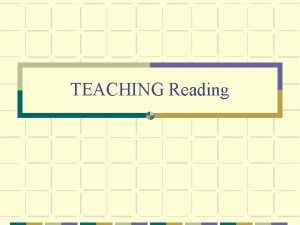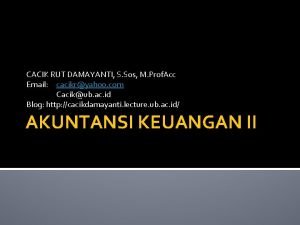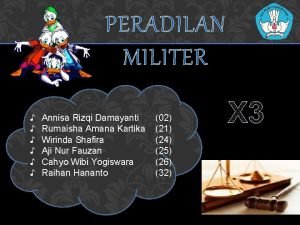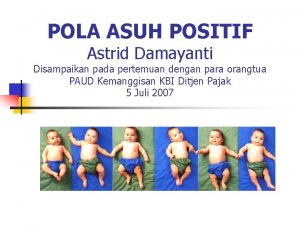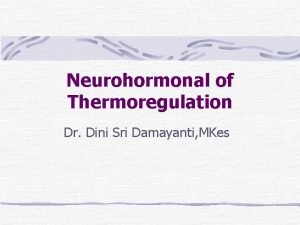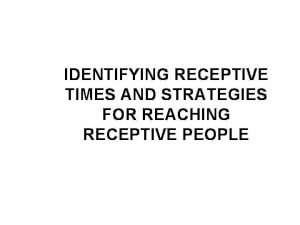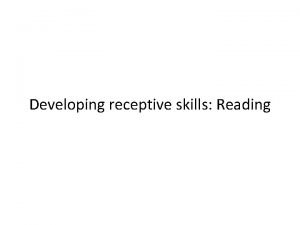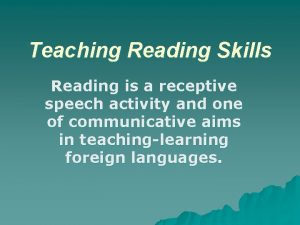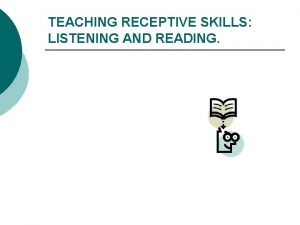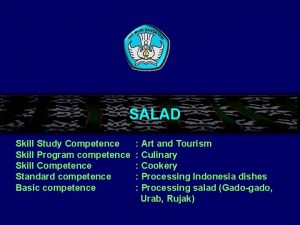TEACHING RECEPTIVE SKILL READING GROUP 7 LIDYA DAMAYANTI










- Slides: 10

TEACHING RECEPTIVE SKILL READING • GROUP 7 • LIDYA DAMAYANTI • TYA NURVILAYANI • FITRI PRAMESWARI

READING • DEFINITION reading is a receptive skill and this fact involves responding to text, rather than producing it, reading involves making sense of text. To do this we need to understand the language of the text at word level, sentence level and whole-text level.

• Our reasons for reading influence how we read, which reading subskill we use: 1. Reading for specific information or scanning: reading a text just to find a specific piece or pieces of information 2. Reading for gist or skimming: reading quickly through a text to get a general idea of what is about 3. Reading for detail: getting the meaning out of every word. 4. Extensive reading: it involves reading long pieces of text. This part is fully explained in the

TEACHING PROCEDURE • The texts chosen are devoted to interest learners in order to motivate them through current topic or news that they can easily know about with realia. In this level of English, learners read articles, brochures, etc. that are what a first language speaker would read, in other words: authentic material.

READING LESSONS SCHEME • The lesson is divided into seven stages : 1. Warm up (6 minutes) * Introduction of the topic of the lesson. Show pictures of characters from famous TV show, made in English-speaking countries. 2. Pre-reading task (15 minutes) * Ask each student to find ten words associated with tv shows from their notes or general knowledge and then ask them to write vocabulary on the board, trying not to duplicate any of the words.

3. Skim (8 minutes) * Ask the students to look at the text quickly on their own and answer three questions. Make sure that the students are aware to the time limit though (2 minutes perhaps), so they don’t get sidetracked. - How many TV channel are there? - How many TV channel broadcast 24 hours a day? If not, when are they off air? - Does each channel broadcast the news? How often? Put the students in pairs to compare their answer and then have a short feedback session with the class.

4. Scan (30 minutes) * Now have the class to look at the text more in more detail. Have them find programmes that match the interest and routines of particular classmate : “is there any football on tv after 9 p. m for Gionnova? ” This is a nice way to personalise the activity and it also encourages the class to make up their own question. * If the students attach no comment to a particular programme, small group can discuss what kind of show it may be, based on the title and time of broadcast : “Property ladder is on once a week at 7 p. m and last for 50 minutes. The name of the presenter is Sarah Beeny. What kind of programme do you think it is? ” Why? * Comparing answers in pairs or small groups is useful for students. Have a class feedback session afterwards to check the answer and correct any vocabulary and grammar

5. Follow up (15 minutes) *Have students form two lines, each person facing a partner. The purpose is to role -play one side of an argument. So, in this case the students in line A argue the case for more foreign TV shows, and the students in line B argue for fewer. After two or three minutes the students in line B can all move along to form new partnerships in the line. Then they can argue again with new points to consider.

6. Homework (5 minutes) * Students can write an essay in four paragraphs on the same argument. Show students how to organise the text – introduction, the argument for more foreign shows, the argument for fewer and a conclusion. 7. Cooler (6 minutes more or less) * Have the students play hangman using the names of international celebrities. Make sure that they pronounce all the letters correctly or they lose points.

CONCLUSION 1. reading is a receptive skill and this fact involves responding to text. 2. Reading subskill are : skimming, scaning, reading for detail, extensive reading. 3. Reading lessons scheme devided into : warm up, pre-reading task, skim, scan, follow up, homework, coller.
